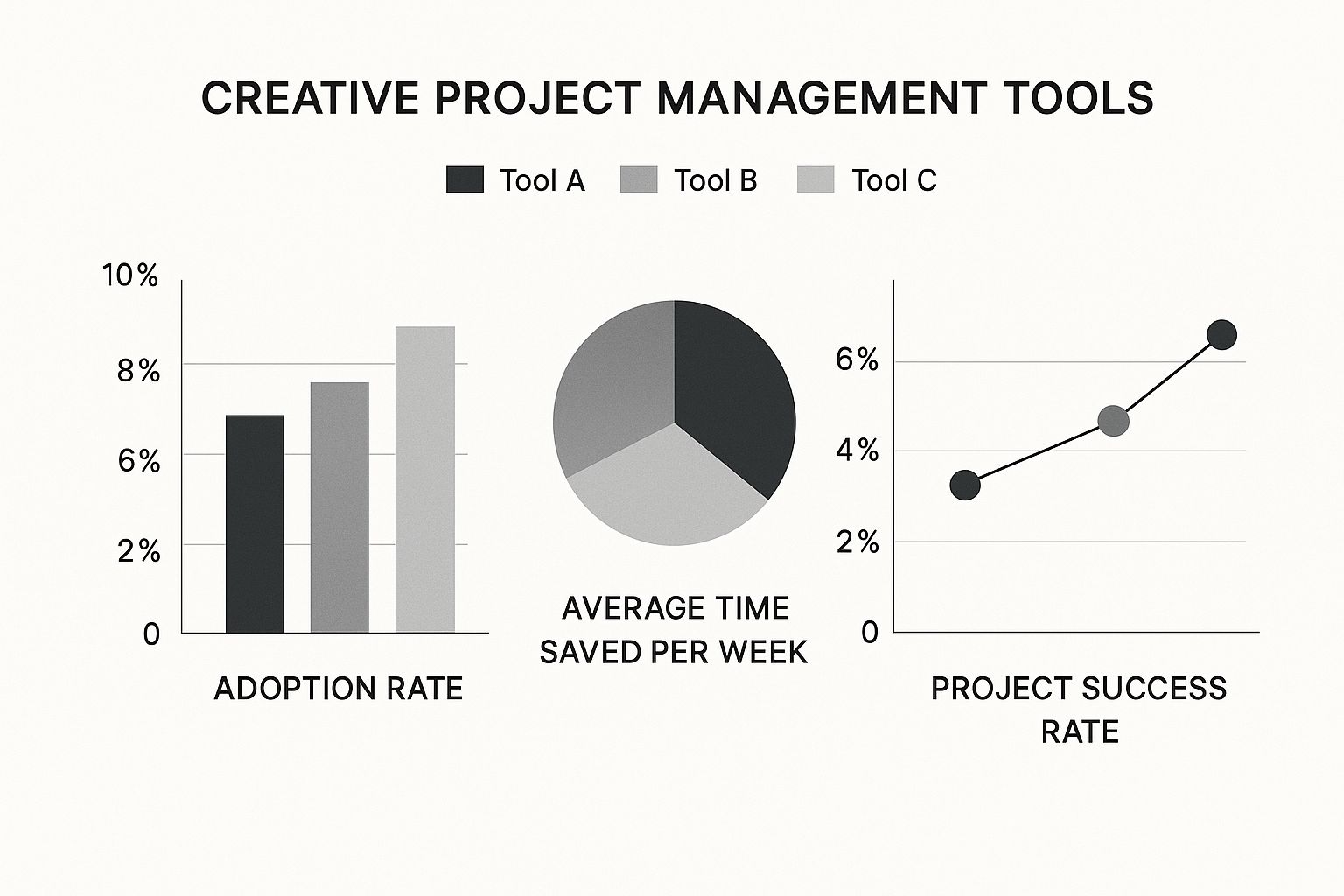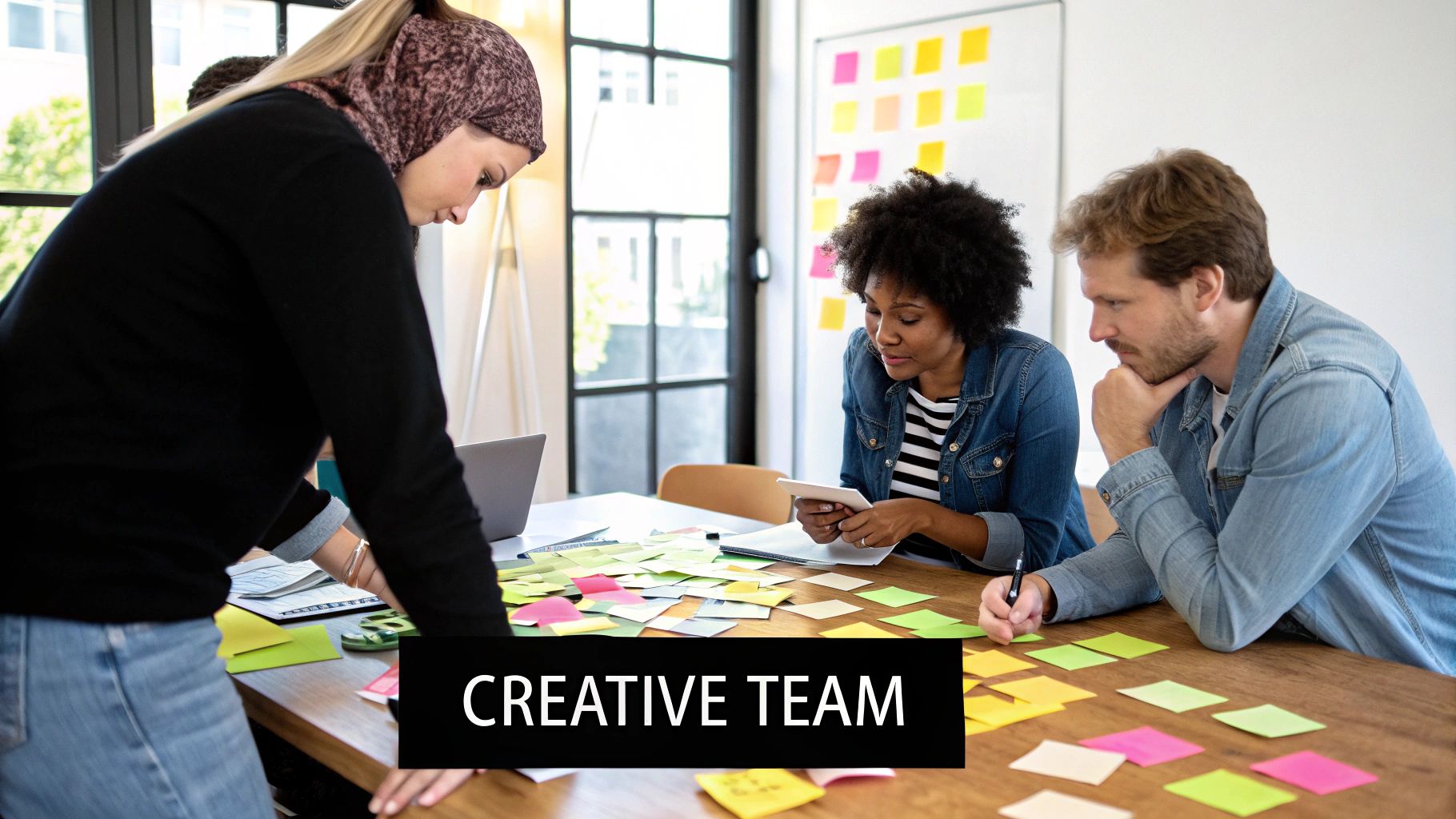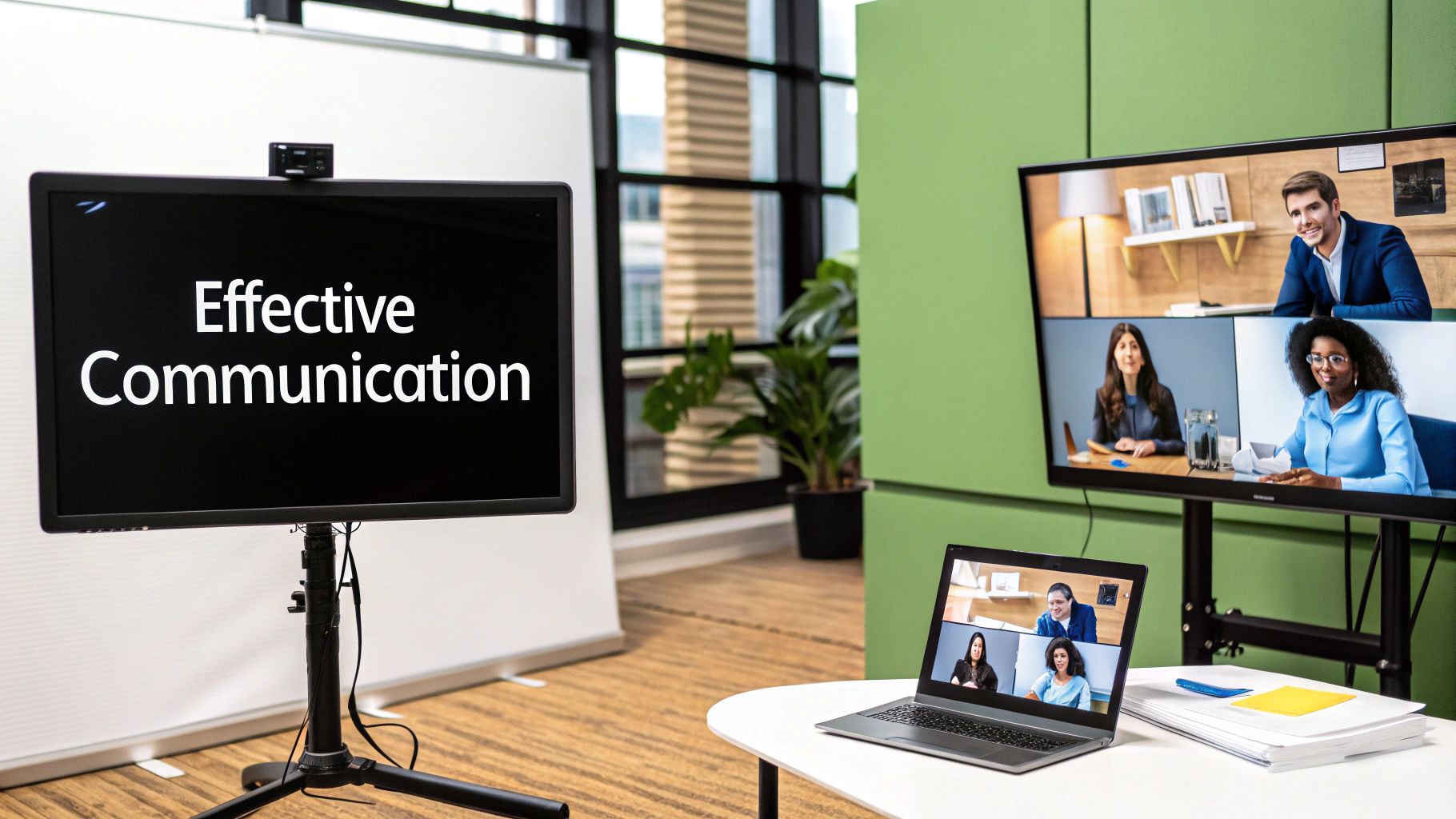The Evolution of Creative Project Management

Creative project management has changed dramatically. The old, rigid, waterfall-style methods, which often stifled creativity, are fading. This shift happened because traditional project management, designed for predictable projects, doesn't work for the dynamic nature of creative work. Imagine forcing the fluid process of brand identity design into a rigid plan. The result? Frustration and limited creativity.
From Rigid Frameworks to Adaptive Approaches
Historically, creative projects focused on strict deadlines and pre-set deliverables. This often caused friction between creative teams and project managers, hindering innovation and collaboration. Creativity was boxed in by the initial plan, leaving little room for exploration. As the demand for innovative creative work grew, the need for adaptable project management became evident.
The Rise of Agile and Hybrid Methodologies
This realization led to adopting more agile and iterative approaches, borrowed from software development. Methodologies like Scrum and Kanban, known for flexibility, entered the creative world. This allows creative teams to respond to new ideas, client feedback, and market changes. The growing complexity of creative projects, often involving diverse teams and deliverables, further fueled this need. This contributed to the rise of hybrid methodologies, combining traditional and agile approaches.
Technology's Role in Modern Creative Project Management
Technology has played a key role in this evolution. In creative project management, technology boosts productivity and efficiency. The use of project management software like Monday.com is increasing globally. By 2025, the project management software market is projected to reach $7.24 billion, with a 10.67% CAGR from 2025 to 2030. Find more detailed statistics here. This highlights the importance of digital tools in managing creative projects. As technology advances, 82% of companies reportedly use project management software to improve efficiency. The integration of artificial intelligence (AI) and hybrid methodologies further emphasizes this shift. This allows teams to collaborate better, streamline workflows, and manage resources effectively, leading to improved project outcomes. From concept to delivery, technology is reshaping creative project management, enabling teams to deliver exceptional work.
Core Principles That Drive Creative Project Success
What separates successful creative projects from those that falter? It all comes down to the core principles that guide effective creative project management. These principles offer a roadmap for handling the unique obstacles inherent in creative work, skillfully balancing structure with the freedom to explore new ideas.
Establishing a Clear Vision While Preserving Creative Autonomy
A key principle is the ability to define a clear vision for the project while also protecting the team's creative autonomy. This involves outlining the project's goals and desired results in a way that offers guidance without stifling innovation. Imagine giving an artist a theme but letting them choose their own style and technique. This balance keeps the project aligned with business objectives while nurturing a space where creativity can thrive.
Setting Meaningful Boundaries That Inspire, Not Restrict
Successful creative project management also depends on establishing meaningful boundaries. These boundaries aren't meant to limit creativity; rather, they create a framework for the team. This could include defining the project scope, budget, and timeline. For instance, a deadline can actually spark creativity as the team concentrates their efforts on delivering within the timeframe. This structure provides focus, enabling the team to channel their creative energy effectively.
Creating Feedback Systems That Elevate Work Quality
Another vital principle is building robust feedback systems. These systems should be designed to improve the work, not to discourage the team. Constructive feedback offers valuable perspectives and helps refine the creative output, resulting in a stronger final product. Regular feedback also ensures the project remains on track and aligned with the client’s vision. This collaborative approach fosters continuous improvement and strengthens the client-team relationship.

The infographic above visually represents data on the adoption rate, average time saved per week, and project success rate for various creative project management tools. The data indicates that tools like Creativize are rapidly gaining popularity because of their positive impact on efficiency and project outcomes. This underscores the importance of selecting the right tools for creative projects. By utilizing effective project management tools, creative teams can streamline their workflows and significantly boost their chances of success.
To further illustrate the differences between traditional and creative project management, let's examine a comparison table:
Traditional vs. Creative Project Management Approaches
This table contrasts conventional project management methodologies with approaches designed for creative projects, highlighting key differences in process, team dynamics, and success metrics.
| Element | Traditional Project Management | Creative Project Management |
|---|---|---|
| Process | Linear, sequential | Iterative, flexible |
| Team Dynamics | Clearly defined roles, hierarchical structure | Collaborative, fluid roles |
| Success Metrics | On-time, on-budget delivery | Innovation, creative impact, client satisfaction |
| Planning | Detailed upfront planning | Adaptive planning, room for changes |
| Communication | Formal, documented | Open, frequent communication |
In summary, traditional project management emphasizes predictable processes and measurable outcomes, while creative project management prioritizes flexibility, collaboration, and the unique needs of creative endeavors. Choosing the right approach depends on the specific project and the nature of the work.
Game-Changing Tools Reshaping Creative Projects

Going beyond basic project management software means understanding what creative teams need. These teams depend on collaboration, visual feedback, and adapting their work as they go. Standard project management tools often miss the mark. They don't address the specific ways creative projects work.
For example, tracking different versions of a design, organizing digital assets, and getting feedback from clients require special features. These features aren't usually found in typical project management apps. That's why using tools designed for creative project management is so important. It helps teams be more productive and streamlines the entire creative process.
Collaborative Platforms That Fuel Creativity
Great creative project management relies on smooth teamwork. Tools like Creativize give teams and clients dedicated spaces to connect. They can share files and give feedback in one central hub. This keeps everyone in the loop, avoiding messy email chains and scattered conversations.
Features like real-time comments on designs and keeping track of different versions are crucial. They help manage the back-and-forth nature of creative work. Built-in messaging keeps communication fast and clear. This minimizes delays and confusion. These platforms become a digital home base for the project. They encourage open communication and help the team feel united.
Specialized Creative Tools and Workflow Integration
Creative teams depend on specialized software. This includes software for design, video editing, and animation. Connecting these tools with project management platforms is key to a streamlined workflow. For example, linking Adobe Creative Cloud to a project management platform allows for automatic file syncing and version control.
This avoids the hassle of manual uploads and ensures everyone has the latest files. Automatically creating tasks based on project milestones keeps the team organized and on track. This integration cuts down on admin work and lets creative professionals focus on what they do best. It boosts both efficiency and output. This connected system of tools changes how creative teams work, making every step of the process better.
Assessing the ROI of Creative Project Management Technology
The market for creative project management software is growing rapidly worldwide. The demand for specialized solutions is fueling this growth. Explore this topic further. But investing in new technology requires careful thought about the return on investment (ROI).
The real benefit is how these tools improve team efficiency, reduce project delays, and make clients happier. Figuring out the ROI means analyzing things like time saved on admin tasks, improved project delivery rates, and how well you keep clients coming back. These concrete benefits lead to cost savings and better profits. This justifies the initial investment in new technology. In the end, the right tools help creative teams produce exceptional work efficiently. They can maximize their creative potential while meeting business goals.
Building Creative Teams That Consistently Deliver
Exceptional creative output isn't solely about individual brilliance; it's about the combined energy of a well-structured team. This section explores the human element that fuels truly successful creative teams. We'll examine the strategies used by creative directors to build teams that consistently produce high-quality work.
Assembling a Diverse and Complementary Team
A successful creative team, much like a captivating photograph, requires a variety of perspectives. Building a team with diverse skills and backgrounds is key to innovation. This includes not only core creative roles like designers and writers, but also strategists, project managers, and even individuals with expertise in other fields. Assembling the right team is crucial. For more insights, explore strategies on building a startup team. This diverse mix introduces fresh viewpoints and innovative problem-solving methods.
Fostering Psychological Safety and Open Communication
Creating a safe environment where team members feel empowered to take risks is paramount. Psychological safety allows people to share ideas without fear of criticism, promoting experimentation and expanding creative boundaries. This can be nurtured by establishing clear communication channels, encouraging open dialogue, and actively listening to every team member's input. This open environment fosters productive brainstorming and ensures everyone feels valued.
Balancing Individual Expression With Collective Goals
Creative work thrives on individual expression. However, it’s equally vital to align individual efforts with the overall project goals. Think of a jazz ensemble – each musician has the freedom to improvise, yet they play together harmoniously to create a unified piece. Creative project management hinges on finding a balance between individual creative freedom and the project’s overarching vision. This can be accomplished by clearly defining project goals and providing regular feedback that both acknowledges individual contributions and reinforces how they support the collective outcome.
Providing Direction Without Stifling Innovation
Effective creative project management involves providing direction without stifling the team’s creative process. It’s a matter of guiding, not dictating. This requires setting clear expectations and offering constructive feedback that helps refine ideas without imposing limitations. This approach maintains project focus while still encouraging experimentation and the development of unexpected, brilliant solutions.
Navigating Interpersonal Dynamics and Creative Egos
Creative teams are dynamic environments, often filled with strong personalities and passionate people. Successfully managing these interpersonal dynamics is crucial for maintaining team cohesion and productivity. This can involve addressing conflicts constructively, celebrating individual accomplishments, and fostering a collaborative spirit where everyone feels supported. Learning how to manage “creative egos” while still nurturing passion is a delicate balance vital for creating a harmonious and productive work environment. Tools like Creativize can be helpful by offering a centralized platform for communication and feedback, helping to maintain transparency and manage expectations.
By embracing these principles, creative teams can not only deliver exceptional work, but also create a positive and rewarding environment. This ultimately leads to greater team satisfaction, increased productivity, and, most importantly, consistently outstanding creative results.
Ethical Frameworks for Modern Creative Projects
Creative project management is no longer just about meeting deadlines and budgets. It's increasingly focused on integrating ethical considerations into each step of the creative journey. This change reflects a growing understanding of the impact creative work has on society, from representation in advertising to the environmental effects of production.
Representation and Diversity in Creative Teams and Output
A critical aspect of ethical creative project management is ensuring diverse representation, both within the team and in the final product. Teams with diverse backgrounds and perspectives generate richer ideas and connect more effectively with a wider audience. This involves considering diversity beyond race and gender, encompassing age, socioeconomic background, and lived experiences.
A diverse team produces more nuanced and inclusive work, avoiding harmful stereotypes and resonating with a broader audience.
Sustainability and Environmental Responsibility
Sustainability is another vital ethical consideration. Creative projects, especially those involving physical production, can have a substantial environmental impact. Ethical creative project managers are increasingly prioritizing sustainable practices, from using recycled materials to minimizing production waste.
For example, choosing eco-friendly printing methods or digital distribution can significantly reduce a project's environmental footprint. These decisions demonstrate a commitment to responsible resource management and a growing awareness of the link between creative work and environmental well-being.
Authentic Storytelling and Avoiding Misrepresentation
Ethical creative project management also means ensuring authentic storytelling and avoiding misrepresentation. This is particularly crucial in marketing and advertising, where there can be a temptation to exaggerate or mislead. Ethical creative teams prioritize honesty and transparency, ensuring their work accurately represents the product or service.
They avoid harmful stereotypes and strive for content that resonates authentically with audiences. This builds consumer trust and strengthens brand reputation over time. Creative project management isn't just about technology; it's about understanding the market's evolving needs. Ethical considerations and innovative solutions are increasingly vital.
In 2025, creative project managers are expected to emphasize ethical creativity, ensuring projects are both commercially successful and aligned with societal values. This trend highlights the shift towards a more holistic approach, where professionals balance artistic vision with ethical responsibility. As a result, creative managers are developing strategies incorporating ethical practices, reflecting a broader societal demand for responsible business. Learn more about the future of creative project management.
Building Client Relationships Grounded in Ethical Practice
Finally, ethical creative project management extends to client relationships built on ethical practice. This includes transparent communication, honest feedback, and delivering on promises. Assembling the right team is essential; for more insights on team composition, consider strategies to build a startup team.
Ethical creative managers focus on building long-term client relationships based on trust and mutual respect. This collaborative approach benefits everyone involved. It also fosters a positive reputation for the creative team, attracting clients and creating opportunities for future collaboration. By integrating these ethical frameworks into creative project management, we ensure creative work not only achieves business goals but also contributes positively to society.
Measuring What Matters in Creative Projects

Evaluating creative project success presents a unique challenge. How do you quantify something as inherently subjective as creativity? Unlike projects with concrete deliverables, creative projects often aim for less tangible outcomes like enhanced brand awareness or emotional resonance with an audience. This necessitates a more nuanced evaluation approach that moves beyond basic metrics.
Balancing Quantitative and Qualitative Evaluation
Effective creative project management hinges on balancing quantitative data with qualitative insights. Numbers such as website traffic and social media engagement offer valuable data points. However, these metrics don't provide a complete picture. Qualitative feedback, gathered through methods like client surveys, focus groups, or team retrospectives, adds essential depth and context to the analysis.
For instance, client satisfaction scores can illuminate how well the project aligned with their expectations. Meanwhile, internal team performance metrics can pinpoint areas for process improvement within the creative workflow.
Frameworks for Evaluating Creative Quality
Several frameworks exist to help evaluate creative quality within practical settings. One approach emphasizes impact, relevance, originality, and craft. This involves assessing how effectively the project achieved its core objectives, its relevance to the intended audience, the originality of the creative concept, and the overall quality of its execution.
Another valuable framework analyzes a project's effectiveness, efficiency, and overall impact. This framework helps determine whether the project delivered the desired results, how efficiently resources were utilized, and the project's ultimate impact on the brand or business.
Translating Creative Successes into Business Value
A key challenge in creative project management lies in demonstrating the tangible business value of creative work. This requires clearly linking creative achievements to concrete business results. For example, a successful branding campaign might boost brand awareness, ultimately driving increased sales or stronger customer loyalty.
Articulating this connection to stakeholders is crucial for demonstrating the return on investment (ROI) of creative projects. This clear communication ensures that the value of creative work is recognized and understood within the broader business context.
Implementing Continuous Improvement Processes
Successful creative project management integrates continuous improvement. This involves consistently reviewing project outcomes, gathering stakeholder feedback, and pinpointing areas for refining the creative process. This feedback loop ensures that each subsequent project benefits from lessons learned, fostering a culture of growth and development within the creative team. Tools like Creativize can support this process by providing a centralized platform for collecting and analyzing feedback.
To further illustrate the key metrics and their measurement approaches, let's examine the following table:
Creative Project Success Metrics Framework
This table outlines key metrics for measuring success across different dimensions of creative projects, from process efficiency to creative impact and business outcomes.
| Dimension | Key Metrics | Measurement Approach | Success Indicators |
|---|---|---|---|
| Process Efficiency | Time spent on tasks, resource utilization, budget adherence | Project management software, time tracking tools | Projects completed on time and within budget |
| Creative Impact | Brand awareness, audience engagement, social media reach | Social media analytics, website traffic data | Increased brand visibility and engagement |
| Business Outcomes | Sales growth, customer acquisition cost, customer lifetime value | Sales data, marketing analytics | Improved business performance |
| Team Performance | Team satisfaction, collaboration effectiveness, skill development | Team surveys, performance reviews | High team morale and productivity |
By integrating these various approaches, creative project managers gain a more holistic understanding of project success, enabling them to make data-driven decisions and continuously elevate their team's creative performance. This comprehensive perspective leads to more effective project management, fostering both creative excellence and measurable business growth.

